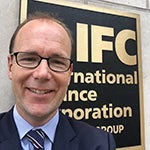Solutions to problems
are easy to find:
the problem’s a great
contribution.
So wrote the Danish poet, inventor, and mathematician Piet Hein. Development finance wasn’t on his mind when he wrote those words. Neither was private sector development. Yet the observation is unmistakably true for the field: To formulate solutions, we must first understand the nature of the problems we are trying to solve.
There is no silver bullet for the complex challenges of development. But blended finance — which involves combining public concessional funds with private capital — is an important part of the solution. It helps crowd in private investment to create markets in difficult places. In an era of limited government resources and donor funds, this is key to achieving sustainable development.
My IFC colleague, Kruskaia Sierra-Escalante, and I have just published a short study that shows how blended finance can be a first step in creating markets — and as such an important part of maximizing finance for development. We examined different projects financed by IFC and identified three main lessons:
First, it is important to assess the need for concessional finance within the context of market restrictions and failures. It’s essential to know the problem before jumping to a solution. The critical questions to ask are: What’s restricting commercial finance? What would make an investment commercially viable? Is the challenge temporary, meaning it could be solved by concessional finance? Or are long-term structural reforms necessary?
Second, blended finance offers the highest return with first-of-their-kind investments and early-stage market creation. Blended-finance solutions can be pivotal in allowing projects to go ahead in situations where extensive risks make financing on commercial terms unachievable. On the other hand, concessional funds are misspent when they support an investment that would have proceeded without them.
It is essential for blended-finance practitioners to be clear about how they intend to change the market, and to think carefully about the role of blended finance in that process. The grander aspiration should be to create systemic change in the marketplace — the kind that will catalyze further investments while keeping the market inclusive and sustainable.
Consider the role of blended finance in IFC’s work to address chronic malnutrition and its effects on human-capital development in Rwanda. A food-processing plant was being built to produce 45,000 tons of fortified cereal per year. Financing on strictly commercial terms was not available — because of a variety of risks, including fluctuating commodity prices.
IFC used blended finance to establish a new space of opportunity. The solution centered on providing blended finance — a combination of subordinated debt and equity financing — that allowed senior lenders to have sufficient downside protection while obtaining a viable return. The need for blended finance to move the transaction forward was identified early — at the project’s concept stage. This was crucial for kickstarting a new market for fortified cereals to combat malnutrition for nearly 1 million children and pregnant and nursing women.
Third , we need to become better at coordinating efforts among development finance institutions . Competition in the development field is significant. To be more effective, development practitioners should share and make better use of lessons on what works and what doesn’t in blended finance. It is important to define the rules of the game and avoid a race to the bottom, where the level of concessional finance becomes a determinant of who wins the deals.
To help ensure an effective use of concessional resources in private sector projects and avoid crowding out private capital, more than 20 development finance institutions recently signed up to a joint report defining enhanced principles for the use of blended concessional finance for private sector projects. This joint work is now continuing to ensure increased transparency and discipline for blended finance in the future.
As another example of cooperation, several development institutions have joined forces to spur job creation and increase access to finance for small and medium enterprises in fragile and conflict-affected states in Africa. With support from the U.K. government, IFC and the European Investment Bank work with Ecobank, a pan-African commercial and banking group, on this initiative. These coordinated efforts helped establish a risk-sharing facility that has expanded access to finance for small businesses in eight African states. This cooperation has created a common sense of direction and a unified vision on how blended finance can help overcome obstacles to market growth in fragile settings.
From problem to solution
As Piet Hein recognized, knowing the problem — and tackling it in a concerted fashion — is crucial to solving it. Just knowing the problem — and articulating it clearly — is a step forward by itself. That was the gist of Piet Hein’s poem, which ends this way:
What’s truly an art
is to wring from your mind
a problem to fit
a solution.
To achieve sustainable development through the blending of public and private finance, we should always ensure that the solutions fit the problem.
Finding what the problem is can be the hardest part.
This post originally appeared on IFC Medium.
Related Posts:
Coming together is the way forward: Maximizing Finance for Development
Boosting access to market-based debt financing for sub-national entities
The art of laying bricks: infrastructure as an asset class
Matching institutional investors and infrastructure investments



Join the Conversation